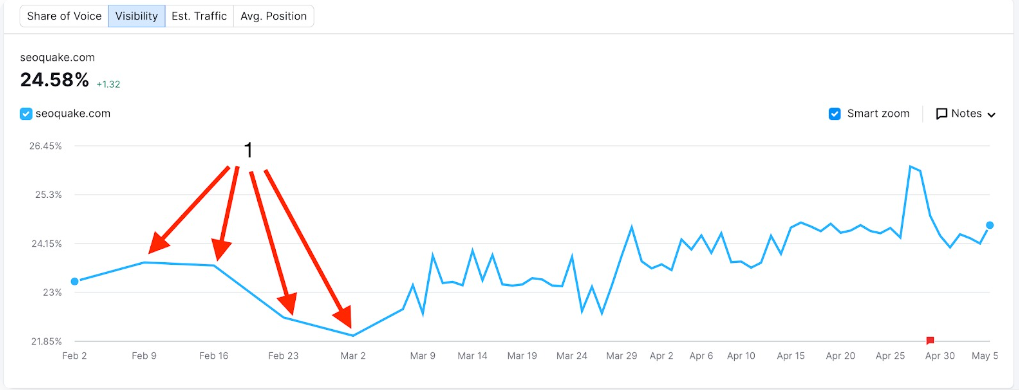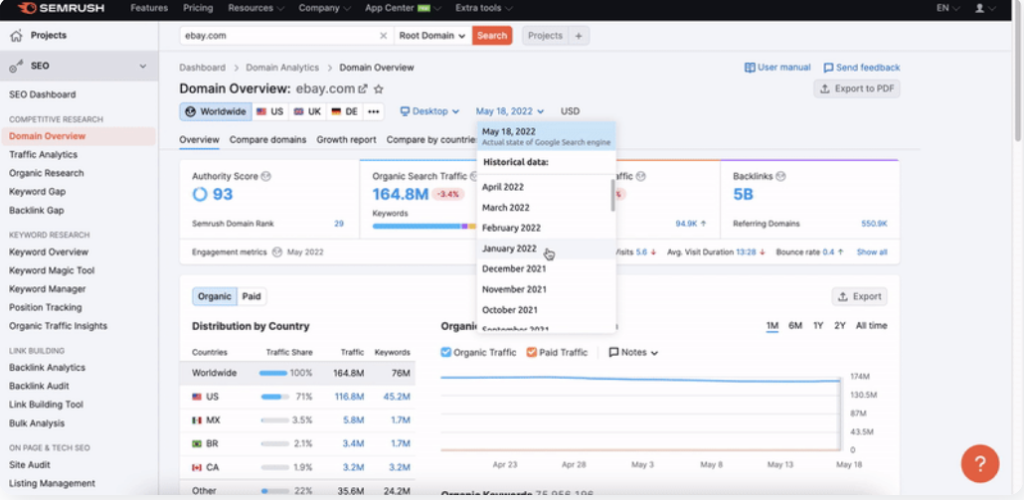Semrush historical data is your secret weapon in the relentless battle for digital supremacy. It gives you a wealth of information about your competition that can help you outrank them in search results and improve your digital marketing efforts.
Whether you’re a seasoned marketer or a small business owner new to the digital world, Semrush can help you gain valuable insights and improve your SEO and digital marketing strategies.
This guide will show you how to use Semrush’s historical analytics to uncover winning tactics and stay ahead of the game.
- Why Semrush Historical Data is a Game-Changer
- What Semrush Historical Data Is
- Getting Started with Semrush Historical Data
- Analyzing Competitor Strategies with Historical Data
- Leveraging Historical Data for Keyword Research
- Improving Your SEO Performance Using Historical Insights
- Measuring Success: Tracking Your Progress Against Competitors
- Advanced Tips and Tricks for Semrush Historical Data
- Final Thoughts: Mastering Semrush Historical Data
- Frequently Asked Questions (FAQs)
- How far back does Semrush’s historical data go?
- Can I use historical data to improve my PPC campaigns as well?
- What’s the difference between Semrush historical data and real-time data regarding SEO strategy?
- How accurate is Semrush’s historical data?
- Can I export historical data reports from Semrush for offline analysis?
Why Semrush Historical Data is a Game-Changer
It’s essential to know what your competitors are doing so that you can stay ahead of the game. Because if you don’t keep an eye on your competitors, you might end up falling behind in terms of market share, sales, and customer loyalty.
Knowing your competitors’ strengths and weaknesses can also help you identify opportunities that you might have missed, and it can give you a better understanding of the industry as a whole.
Semrush historical data is a tool that can help you do just that.
It provides unparalleled insights into your competitors’ SEO and advertising strategies. This means you can see how they have changed their approach over time, what worked for them, and what didn’t.
With Semrush, you can pinpoint when your competitors improved their search engine rankings by changing their websites. This information can be precious in helping you make informed decisions and develop effective strategies.
Using Semrush, you can gain a competitive edge and stay ahead of the curve.
What Semrush Historical Data Is

Semrush historical data provides many analytics, including backlink analytics, keyword rankings, and traffic sources over time. This data is critical for understanding your and your competitors’ online presence and the journey to get there.
Backlink Analytics
Understand the growth and decline of backlink profiles, identifying which links have contributed to your competitors’ SEO success.
Keyword Rankings
Track the history of keyword rankings to identify which keywords have been most beneficial for your competitors and when they started ranking for them.
Traffic Sources
Analyze changes in traffic sources to understand how your competitors have diversified their traffic and what channels are most effective for them.
Getting Started with Semrush Historical Data

Accessing and using Semrush historical data is straightforward but requires a strategic approach to be effective:
Accessing Historical Data
First, navigate to the Semrush dashboard. Select the ‘Historical Data’ option within the various tools, such as Keyword Analytics or Domain Analytics.
Start by logging into your Semrush account. The dashboard is your central hub for all SEO and marketing analytics. From here, look for the ‘Historical Data’ option.
Setting Up Your Project
To track and analyze competitor data effectively, set up a project for your domain and add your competitors. This allows for direct comparison and tracking over time.
Defining Your Objectives
Before delving into the data, take a moment to define what you hope to achieve with your analysis. Clear objectives will guide your data exploration and ensure your efforts are focused and effective.
Use Filters for Tailored Insights
Use filters to refine the data you’re viewing. For instance, you can filter by date range to focus on specific periods of interest.
You can refine by geographic location to see performance in different markets or by specific keywords to understand how rankings for those terms have evolved.
Regularly Monitoring and Updating Your Analysis
Use Semrush’s alert system to notify you of significant rankings, backlinks, or keyword position shifts. This ensures you’re always aware of the competitive landscape without needing to sift through data manually.
Analyzing Competitor Strategies with Historical Data
One of the most powerful features of Semrush historical data is its ability to reveal the evolution of your competitor’s strategies. By examining their SEO efforts, you can uncover valuable insights:
Interpreting Changes
Look at the timeline of your competitor’s SEO strategies to identify when significant changes occurred. Did they shift their focus to new keywords or gain backlinks from high-authority sites at a specific time? These changes can indicate strategic shifts you might consider for your efforts.
Trend Identification
Identify trends in competitor keyword performance. Which keywords have they consistently ranked for, and which have seen fluctuations? This analysis can help you spot opportunities for your keyword targeting.
Advanced Interpretation of SEO Strategy Shifts
Delve deeper into the specifics of any shift in keyword focus. Utilize Semrush to analyze the search volume, competition level, and performance of new keywords they targeted.
Examine the quality and source of backlinks your competitors acquired. This can inspire your content creation efforts to attract similar high-quality backlinks.
Strategic Application of Insights
Use your findings to benchmark your site’s performance against competitors. This can help set realistic SEO goals and prioritize efforts yielding the highest return.
Also, schedule quarterly reviews of your competitors’ strategies to stay informed of any changes and adapt your SEO plan accordingly.
Leveraging Historical Data for Keyword Research
Keyword research is foundational to SEO success, and Semrush historical data offers a goldmine of insights for refining your keyword strategy:
Profitable Keywords
Use historical trends to identify which keywords have consistently driven traffic to your competitors. These are likely to be profitable keywords that you should consider targeting.
Keyword Expansion
Historical data can reveal gaps in your keyword strategy. Look for keywords that have gained popularity but are not yet highly competitive. These could represent opportunities for quick wins.
Prioritize keywords
Prioritize keywords based on their potential impact on your SEO goals. Quick wins can be achieved by targeting low-competition, high-volume keywords that increase traffic.
Continuously monitor the performance of your targeted keywords using Semrush.
Dive into analytics to understand how users interact with your content. Which keywords drive the most engagement, and which pages convert at the highest rates?
These insights can inform future content updates and optimizations, ensuring your strategy aligns with user interests and search trends.
Improving Your SEO Performance Using Historical Insights
Historical data not only informs you about the past; it provides actionable insights to improve your future SEO performance:
User Experience and Performance Analysis
Assess UX and site performance changes to see their impact on user behavior and SEO, using past data to inform future website improvements.
Keyword and SERP Feature Focus
Track keyword ranking fluctuations and opportunities for SERP features like featured snippets, adjusting strategies based on historical successes and shifts.
Social Signals and Content Sharing
Analyze social share trends to identify which content types gain traction, guiding your social media and content strategies for broader engagement.
Technical SEO Enhancements
Review past technical SEO audits for recurring issues and optimize site structure and internal linking based on historical insights for better search visibility.
Measuring Success: Tracking Your Progress Against Competitors
SEO success is about improving your site’s performance and outperforming your competitors. Semrush’s historical data allows for precise tracking and benchmarking:
Set Targeted Benchmarks:
Analyze historical data to establish realistic benchmarks for keyword rankings, traffic growth, and backlink development, reflecting achievable industry standards.
Monitor and Compare:
Regularly review your SEO metrics against these benchmarks and conduct real-time comparisons with competitors’ performances. This approach helps pinpoint your standing and identify strategic opportunities.
Adjust Strategies Proactively:
Based on continuous monitoring and competitive analysis, adapt your SEO strategies to address gaps, leverage strengths, and capitalize on competitors’ vulnerabilities.
Advanced Tips and Tricks for Semrush Historical Data
To truly maximize the benefits of Semrush historical data, consider these expert tips:
Forecasting
Use historical data trends to forecast future changes in your industry. This can help you stay ahead of the curve and adjust your strategies proactively.
Strategic Planning
Combine historical data analysis with your current insights to inform your strategic planning. This holistic approach ensures that your strategies are informed by past successes and optimized for future trends.
Final Thoughts: Mastering Semrush Historical Data
If you want your business to succeed online, you must ensure people can find you easily on search engines.
One way to do that is by leveraging Semrush’s historical data. This tool helps you see how your website performs compared to your competitors. By setting goals, keeping an eye on your progress, and changing your approach when needed, you can ensure your website performs better than others in your industry.
However, this can be hard to understand and manage independently, especially when you’re busy running your business. That’s why you can rely on Flying V Group, a team of experts who can help you use Semrush to improve your online performance and beat your competitors.
With our help, you can succeed online and make sure your business stands out.
Frequently Asked Questions (FAQs)
How far back does Semrush’s historical data go?
Semrush offers historical data from several years, providing a comprehensive view of long-term trends.
Can I use historical data to improve my PPC campaigns as well?
Yes, historical data on keyword performance and competitor ad strategies can inform more effective PPC campaign planning.
What’s the difference between Semrush historical data and real-time data regarding SEO strategy?
Historical data helps understand trends over time and the impact of past strategies, while real-time data is crucial for immediate decision-making and adjustments.
How accurate is Semrush’s historical data?
Semrush is known for its robust data collection methodologies, making its historical data highly reliable for strategic analysis.
Can I export historical data reports from Semrush for offline analysis?
Yes, Semrush allows for the export of data reports, enabling offline analysis and sharing with team members.






0 Comments